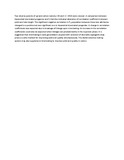| dc.contributor.author | Tyagi, AP | |
| dc.date.accessioned | 2015-07-24T06:20:22Z | |
| dc.date.available | 2015-07-24T06:20:22Z | |
| dc.date.issued | 1987 | |
| dc.identifier.citation | Theoretical and Applied Genetics June 1987, Volume 74, Issue 2, pp 280-283 | en_US |
| dc.identifier.uri | http://link.springer.com/article/10.1007/BF00289981 | |
| dc.identifier.uri | http://hdl.handle.net/11295/88729 | |
| dc.description.abstract | Two diverse parents of upland cotton namely J.34 and I.C. 1926 were crossed. A comparison between biparental intermated progenies and F3 families indicated alteration of correlation coefficient between yield and halo length. The significant negative correlation in F3 population between these two attributes changed to a positive but non significant one in biparental intermated progenies. A change in correlation coefficients was expected due to breakage of linkage upon intermating. An increase in the correlation coefficients could also be expected when linkages are predominantly in the repulsion phase. It is suggested that intermating in early generations coupled with selection of desirable segregants may prove a useful method for improving yield and quality simultaneously. The diallel selective mating system may also supplement intermating to improve yield and quality in cotton. | en_US |
| dc.language.iso | en | en_US |
| dc.publisher | University of Nairobi | en_US |
| dc.title | Correlation studies on yield and fibre traits in upland cotton (Gossypium hirsutum L.) | en_US |
| dc.type | Article | en_US |
| dc.type.material | en | en_US |

